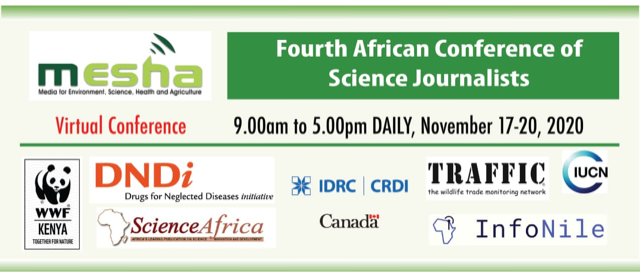The fourth African Conference of Science Journalists (ACSJ IV) is underway virtually, on the theme: “Bolstering the Role of Science Journalism during a Pandemic and an ‘Infodemic’”, and one of the issues that have come up strongly, is the need for global attention on neglected diseases.

These are not high-profile diseases like cancer, malaria and now COVID-19 and may not be global in scope but are endemic and pertain to certain geographical areas or afflict only a specific age group and are equally devastating.
Yet, these diseases have been neglected for decades as the world continues to battle in finding permanent cures to high-profile age-old diseases and emerging ones especially the current COVID-19 that is devastating homes, families and nations.
Health researchers say these neglected diseases include Mycetoma, a bacterial or fungal infection that can be devastating, and can result in amputation, and Paediatric or children’s HIV. These as well as other health, environment, science issues in relation to Africa’s socio-economic development are being discussed at the conference.
The four-day conference, which started on Tuesday, November 17, 2020 and will end on Friday, November 19, 2020, is being jointly organised by the Media for Environment Science Health and Agriculture (MESHA) IDRC, WWF-Kenya and Drugs for Neglected Diseases Initiative (DNDi) in collaboration with ScienceAfrica and InfoNile. About 100 African science journalists, communications professionals, scientists, and policy makers are participating in the conference, which is being held virtually for the first time, since its inception in 2012.
The HIV Access and Medical Affairs Leader of the Drugs for Neglected Diseases Initiative (DNDi) Africa Regional Office in Nariobi, Kenya, Dr. Irene Mukui addressed the opening session, on the topic: “Ending the Neglect: Finding improved treatments for children with HIV.” She said HIV treatment for children is very important, because of the numbers involved, and the rate and mode of infection.
Worldwide, 1.8 million children under 15 years are living with HIV, and only half of them are receiving antiretroviral (ARV) therapy or HIV Treatment. Also, about 400 children under 15 years are infected every day, 90% of infections occur through mother to child transmission, close to 300 children die daily and 90% of paediatric infections are in subSaharan Africa. While, in many African countries, access to HIV testing for infants and children remains poor.
Dr. Mukui explained the factors that have led to this situation – The paediatric or children’s ARV market is particularly vulnerable and complex; while the children’s market is low and therefore commercially unviable. This is because children require different dosages and dosage formulations of ARV as they gain weight, hence, making Paediatric HIV treatment more expensive per child, than that for adults. Additionally, children’s care depends on others, sometimes multiple care givers and orphanhood is a major challenge.
She observed that “the situation of Paediatric HIV has been worsened in 2020 by COVID 19 as the attendant restriction of movement resulted in limited access to care, loss of livelihood for households and delays in supply of HIV medicines to countries.”
To address this situation, Dr. Mukui proposed that HIV diagnosis and testing for children needs to be more available and closer to children, while medicines specifically adapted to the needs of children need to be developed and kept at an affordable price.
She urged governments, nongovernmental organisations, research partners, health experts, civil society and the media to advocate strongly for the development of child-friendly combinations to make treatment easier for children and further called for health workers to be trained to provide effective HIV services for children living with HIV.
Presenting an overview of research on the neglected tropical disease – Mycetoma, a Senior Clinical Project Manager and Medical Manager also of the DNDi, Dr. Borna Nyaoke-Anoke, called for greater global advocacy on the disease, which can be devastating and lead to amputation.
She explained that, currently, basic epidemiological information on Mycetome is lacking and the global burden remains unknown, as research is very minimal with an active research centre based in Khartoum, Sudan. The disease is endemic in Africa, more difficult to treat and the cure rate with antifungals is only 25 to 35%. Besides, its route of transmission is not yet defined, but infection may come from the soil or animal dung and is suspected to enter the body after the skin has been pricked by things like thorns.
Dr. Nyaoke-Anoke is concerned that this disease cannot even be easily tested, and treatment is dependent on expensive antibiotics for a 12-month period.
“There is no point-of-care diagonostic test; current treatment is long, ineffective, and expensive with serious side effects.” She said, adding that intensive research could bring about the development of “a more effective, affordable, shorter-term treatment appropriate for rural settings.”
Dr. Nyaoke-Anoke, is hopeful that “now that Mycetome has been added to the World Health Organisation’s list of neglected diseases, it will attract more visibility for funding and research programmes.”
She proposed that clinical solutions to Mycetome should include early case detection and management as well as health education focused on preventive measures such as wearing shoes in the field, observing environmental hygiene, early treatment of suspected cases and health care provider training.
A press statement issued earlier by MESHA’s Director and the Conference Director, Aghan Daniel, said the conference seeks to empower science journalists with tips and tools to produce factual stories, so as to improve science journalists’ ability to detect and decipher disinformation.
Furthermore, it is providing a platform to identify opportunities and threats to science journalism in a post-COVID-19 world.
By Ama Kudom-Agyemang
